
London: The first modern Briton had dark skin and blue eyes, London scientists said on Wednesday, following groundbreaking DNA analysis of the remains of a man who lived 10,000 years ago.
Known as “Cheddar Man” after the area in southwest England where his skeleton was discovered in a cave in 1903, the ancient man has been brought to life through the first ever full DNA analysis of his remains.
In a joint project between Britain’s Natural History Museum and University College London, scientists drilled a 2mm hole into the skull and extracted bone powder for analysis.
Their findings transformed the way they had previously seen Cheddar Man, who had been portrayed as having brown eyes and light skin in an earlier model.
“It is very surprising that a Brit 10,000 years ago could have that combination of very blue eyes but really dark skin,” said the museum’s Chris Stringer, who for the past decade has analysed the bones of people found in the cave.
The findings suggest that lighter pigmentation being a feature of populations of northern Europe is more recent than previously thought.
Cheddar Man’s tribe migrated to Britain at the end of the last Ice Age and his DNA has been linked to individuals discovered in modern-day Spain, Hungary and Luxembourg.
Selina Brace, a researcher of ancient DNA at the museum, said the cave environment Cheddar Man was found in helped preserve his remains.
“In the cave you have a really nice, cool, dry, constant environment, and that basically prevents the DNA from breaking down,” she said.
A bust of Cheddar Man, complete with shoulder-length dark hair and short facial hair, was created using 3D printing.
It took close to three months to build the model, with its makers using a high-tech scanner which had been designed for the International Space Station.
The groundbreaking discovery made in a “stroke of luck” shows that, contrary to popular belief, the founding generations of Britons owed more in appearance to Paleolithic Africans, from whom all humans descend.
Last night scientists said they show that commonly used racial categories are historically only “recent constructions”. Up to nine previous colonisations of Britain, via a European land bridge known as Doggerland, had been wiped out due to harsh temperatures. But the humans of the roughly 12,000-strong Cheddar Man age thrived, and their DNA now comprises roughly 10 per cent of the genetic make-up of most white people living in the UK. They lived mainly in tents made from animal skins and preyed on animals such as deer and wild boar using hunting dogs and bows and arrows.
Dr Yoan Dieckmann, from University College London, who took part in the project, said: “The historical perspective that you get just tells you that things change, things are in flux, and what may seem as a cemented truth, that people feel the British should have white skin through time, is not at all something that is an immutable truth.It has always changed and will change.”
Archeologists already knew Cheddar Man was about 5ft five 5in, around 10st and with good teeth, and that he died in his early 20s. But genetic sequencing that would have been impossible just 10 years ago have now allowed them to determine the colour of his skin, eyes, and hair.
“The combination of quite dark skin and blue eyes is something that we don’t imagine is typical, but that was the real appearance of these people, something that’s quite rare today,” Stringersaid.
Alfons Kennis, who made the bust with his brother Adrie, said the DNA findings were “revolutionary”.
“It’s a story all about migrations throughout history,” he told Channel 4 in a documentary to be aired on February 18.
“It maybe gets rid of the idea that you have to look a certain way to be from somewhere. We are all immigrants,” he added.













